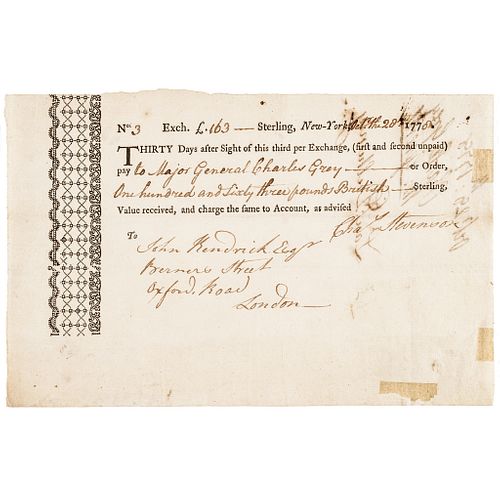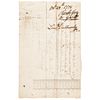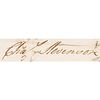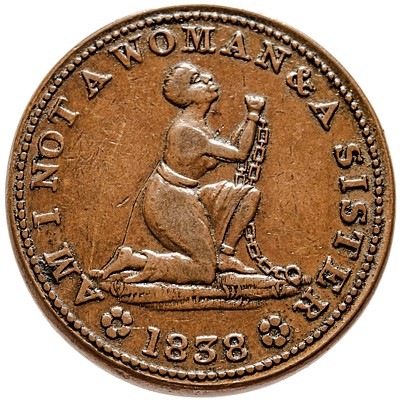1778 CHARLES GREY British Maj General in America Signed Sight Draft NY to London
Lot 138
Categories
Estimate:
$1,800 - $2,400
Absentee vs Live bid
Two ways to bid:
- Leave a max absentee bid and the platform will bid on your behalf up to your maximum bid during the live auction.
- Bid live during the auction and your bids will be submitted real-time to the auctioneer.
Bid Increments
| Price | Bid Increment |
|---|---|
| $0 | $10 |
| $200 | $20 |
| $300 | $25 |
| $500 | $50 |
| $1,000 | $100 |
| $2,000 | $200 |
| $3,000 | $250 |
| $5,000 | $500 |
| $10,000 | $1,000 |
| $20,000 | $2,000 |
| $30,000 | $2,500 |
| $50,000 | $5,000 |
| $100,000 | $10,000 |
| $200,000 | $20,000 |
| $300,000 | $25,000 |
| $500,000 | $50,000 |
About Auction
By Early American History Auctions
Feb 27, 2021
Set Reminder
2021-02-27 12:00:00
2021-02-27 12:00:00
America/New_York
Bidsquare
Bidsquare : Black History & Slavery, Historic Autographs, Colonial America & Weapons
https://www.bidsquare.com/auctions/early-american-history-auctions/black-history-slavery-historic-autographs-colonial-america-weapons-6434
318 Lots of Rare, Historic Autographs, Americana, Civil War Era, George Washington, Abraham Lincoln, Slavery & Black History, Revolutionary War Era, Colonial America, Federal Period, War of 1812, Colonial Currency, Historic Early American Guns & more... Early American History Auctions auctions@earlyamerican.com
318 Lots of Rare, Historic Autographs, Americana, Civil War Era, George Washington, Abraham Lincoln, Slavery & Black History, Revolutionary War Era, Colonial America, Federal Period, War of 1812, Colonial Currency, Historic Early American Guns & more... Early American History Auctions auctions@earlyamerican.com
- Lot Description
Autographs
1778 30-Day Sight Draft British Major General CHARLES "NO FLINT" GREY at New York Made Payable in London
CHARLES "NO FLINT" GREY (1729-1807). British Major General who Fought in the American Revolutionary War, later was Appointed "Commander-in-Chief of the British Troops in America" but hostilities ended before he could take command.
October 28th, 1778-Dated Revolutionary War Period, Extraordinary and rare, Partially-Printed 30-Day Sight Draft Financial Exchange Order for 163 British Pounds Sterling made to, "pay Major General Charles Grey od Order, 163 Pounds British Sterling." This boldly printed draft is partially-printed and nicely completed in manuscript, 1 page, issued at New York, printed on clean fine quality "GR" British watermarked laid period paper, measuring 5.75" x 9," Choice Extremely Fine. This was an 3rd International Order to pay, originating in New York and ending payable into Grey's account located in London. General Grey's bold endorsement can be seen on the blank reverse reading, in full: "Octr. 28th: 1778 - Charles Grey M: (Major) General" his bold flourish below, and witnessed by Lau: (Laurence) Dulhenly. Some trivial ink burn at the date, some stamp hinge residue at right and bottom edges, all well away from the richly printed black text.
As a historical note: About the time prior to this Payment Exchange Draft was issued, in 1778 Grey led raids at New Bedford on 5-6 September, destroying nearly all the shipping and burning twenty shops and twenty-two houses in the town, and Martha's Vineyard, where between the 10th and 15th of September, the British carried off all the sheep, swine, cattle and oxen that they could find with promise of payment in New York. On 27th September 1778, Grey used the same methods as he had at the Battle of Paoli, in a controversial night attack at Old Tappan, New Jersey, which came to be known as the "Baylor Massacre". General Grey was later recalled to England and became a "Knight of the Order of the Bath" and a Lieutenant General. He was later Appointed "Commander-in-Chief of the British Troops in America" but hostilities ended before he could take command. This Payment Draft sending money from New York to his account in London may involve his funds received at that time, as Signed and Dated by Grey.
Extremely rare, the first example of a payment to a Revolutionary War dated British Major General while actively serving in America we have offered.
CHARLES GREY, 1st Earl Grey KB PC served as a British General in the 18th century. A distinguished soldier in a generation of exceptionally capable military and naval personnel, he served in the Seven Years' War of 1756-1763, taking part in the defeat of France. He later served in the American War of Independence (1775-1783) and in the early campaigns against France during the French Revolutionary War. Following the Battle of Paoli in Pennsylvania in 1777 he became known as "No-flint Grey" for ordering his men to "extract the flints" from their muskets during a night approach, and to fight with the bayonet only.
CHARLES "NO FLINT" GREY (1729-1807). In the Seven Years' War, he served as adjutant in the staff of Duke Ferdinand of Brunswick and on 1 August 1759 was wounded at Minden. On 14 October 1760 he commanded a Light Company at the Battle of Campen, where he was again wounded. One year later, as Lt. Colonel of the 98th Regiment of Foot (1761), he participated in the Capture of Belle le, off the coast of Brittany.
Next, he served at the Battle of Havana in 1762. Later, he was on the staff of Wilhelm, Count of Schaumburg-Lippe during the Spanish invasion of Portugal (1762). In 1763 he retired on half-pay, but in 1772 he received a promotion to Colonel and served as aide-de-camp to King George III.
During the American War of Independence he was one of the more successful army leaders. He was rapidly promoted, becoming a Major General in 1777 and commanded the 3rd Brigade at the Battle of Brandywine. He earned the nickname "No-flint Grey" after the Battle of Paoli in the same campaign when, to ensure surprise in the night attack on an American encampment, it was said he ordered the infantry of his command to remove the flints from their muskets and use only their bayonets. In fact, he only directed that muskets should be unloaded.
He commanded the 3rd Brigade again at the Battle of Germantown and the Battle of Monmouth. Immediately following his disastrous retreat at the Battle of Monmouth the American General Charles Lee excused himself from criticism by complaining that he had directly faced the advance Grey's 3rd brigade. Suggesting the Earl was a feared and respected opponent by this stage in the war.
In 1778 he led raids at New Bedford on 5-6 September, destroying nearly all the shipping and burning twenty shops and twenty-two houses in the town, and Martha's Vineyard, where between 10 and 15 September, the British carried off all the sheep, swine, cattle and oxen that they could find with promise of payment in New York. On 27 September 1778, Grey used the same methods as he had at the Battle of Paoli, in a controversial night attack at Old Tappan, New Jersey, which came to be known as the "Baylor Massacre".
He was recalled to England and became a knight of the Order of the Bath and a lieutenant general. He later was appointed commander-in-chief of the British troops in America, but hostilities ended before he could take command.
At the outset of the war with Revolutionary France, in 1793, Sir Charles Grey was appointed commander of the West Indian expedition. First, however, he went to Ostend to participate in the relief of Nieuwpoort, Belgium. In early 1794, he and Admiral Sir John Jervis led a British force to capture Martinique. The campaign lasted about six weeks with the British capturing Fort Royal and Fort Saint Louis on 22 March, and Fort Bourbon two days later. The British then occupied Martinique until the Treaty of Amiens returned the island to the French in 1802. Next Grey was involved in the invasion of Guadeloupe.
Between the years of 1797 and 1807 General Grey held the position of Governor of Guernsey, in the Channel Islands. He died in 1807, at the age of 78.
Our Auction Contents:
Black History & Slavery: (Lots 1 - 63)
Abraham Lincoln Related: (Lots 64 - 74)
Historic Autographs: (Lots 75 - 235)
Colonial America: (Lots 236 - 261)
Revolutionary War: (Lots 262 - 304)
George Washington Related: (Lots 305 - 306)
Early American Guns & Weapons: (Lots 307 - 318) - Shipping Info
-
Early American provides in-house worldwide shipping. Please contact us directly if you have questions about your specific shipping requirements.
-
- Buyer's Premium



 EUR
EUR CAD
CAD AUD
AUD GBP
GBP MXN
MXN HKD
HKD CNY
CNY MYR
MYR SEK
SEK SGD
SGD CHF
CHF THB
THB













